Apr 22, 2016
The Mount Sinai Archives has installed its latest quarterly exhibit in the lobby of the Annenberg Building. This season’s exhibit, “Hospital Trustees and the Making of New York City,” looks at the role of some of the trustees of the Mount Sinai Health System hospitals, accomplished figures who left their mark not only on their respective hospitals but on New York City as a whole.
One exhibit case contains photographs and memorabilia documenting the life and career of Charles H. Silver, who served for nearly five decades as President of the Board of Trustees at the Beth Israel Medical Center, the predecessor of today’s Mount Sinai Beth Israel. (Some of the highlights of the Mount Sinai Archives’ Silver collection have previously been featured on the blog.) The child of impoverished Lower East Side immigrants who worked his way up to wealth and influence, Silver was active in politics and philanthropy, chaired the New York City Board of Education, and was a pioneer of interfaith relations in a multicultural global city.
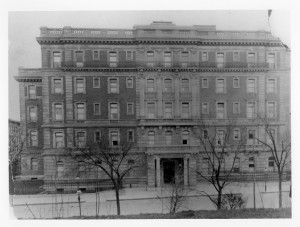
Pictured: The original Mount Sinai Private Pavilion, built in 1904 with an endowment from the Guggenheim family.
The second exhibit case documents the legacy of the Guggenheim family at Mount Sinai. The role of the Guggenheims in New York City philanthropy is perhaps best known in connection with the Guggenheim Museum, but members of the family also played an important role at Mount Sinai, where they served as Trustees, donors, and vocal supporters from 1889 until the end of the 20th century. Since 1904, their name has been on Mount Sinai’s largest patient care building, a symbol of their dedication to the city and people of New York.
This quarter’s Nursing History exhibit, located underneath the stairs to Stern Auditorium, documents the participation of Mount Sinai School of Nursing graduates in the Spanish-American War and the Spanish Civil War, the latter of which marks its 80th anniversary this year.
Apr 15, 2016
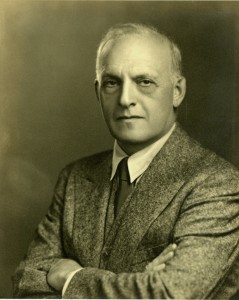
Dr. S. S. Goldwater, Director of The Mount Sinai Hospital from 1903-1928
Every month is a celebration of something, and April is National Poetry Month. In keeping with the season, the Mount Sinai Archives would like to offer up a poem. This was written by S. S. Goldwater, MD (1873-1942). He served as the Director (COO) of The Mount Sinai Hospital from 1903-1928 and also served as the New York City Commissioner of Health and the Commissioner of Hospitals. He was known as one of the foremost consultants on hospital architecture in his era, and helped create the field of modern hospital administration. He loved to write poetry and often exchanged poems with his friends. He wrote the poem below for the celebration of The Mount Sinai Hospital’s 90th anniversary in 1942, just a few months before he died. It was reprinted in a memorial booklet after his death:
In closing, let me address these lines to your distinguished President, to your faithful and energetic Director, and to those members of the Board and Staff with whom it was my privilege to be associated for a time in the development of this great institution:
Full many a year has passed since you and I
Began to think in unison, and talk
Of what a hospital is and what it should be.
Well, thoughts like ours do not die a-borning
But, seized by eager wills, emerge as deeds,
By which new shapes are formed, reshaped again,
Until the world about us is part Nature’s,
Part our own.
Although we’ve not achieved
The perfect institution of our dreams—
Of love, and art, and science all compact—
Rejoice we may, for we have lived to see
The hospital we cherish yield to change
From small to great, from careless to exact,
From home of sorry pestilence to proud
And comely scene of perfect cleanliness
Equipped with all that science knows to aid
Physician, nurse, and sick, to whom in honor
We pledge again our faithful, firm support.
Apr 7, 2016
In the October 1925 meeting of The Mount Sinai Hospital Board of Trustees minutes, the Trustees discuss a request from the House Staff for the Hospital to build a golf cage on the roof of the staff housing. The Trustees agreed but wanted the Medical Board to approve it and to decide “whether it might not be detrimental to the care of the patients to furnish this additional amusement to the house staff.” The project was eventually approved by the Medical Board, but it is unclear if the golf cage was ever built.
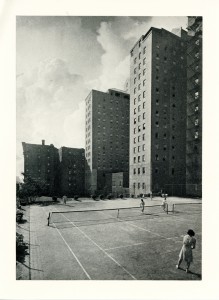
The Mount Sinai tennis courts, at Fifth Avenue and 99th Street.
This request was part of a trend for the active House Staff. In 1923, the Board had approved funds to build a tennis court for the Mount Sinai medical staff and School of Nursing students. It was erected on the corner of Fifth Avenue and 99th Street. Sadly, it was closed in 1948 to make way for the Klingenstein Pavilion.
In a 1988 interview, Gus Burton, a Radiology Technician, discusses what it was like when he was hired in 1948. He says that he was the second Black man hired at Mount Sinai in a non‑janitorial position. He mentioned these tennis courts:
Q. Why did you come here? Tell me a little about why Mount Sinai.
Burton: It’s very interesting. Back in those days the buses that ran along Fifth Avenue were owned by a company called the Fifth Avenue Bus Company. They had double deckers. The top deck was so that you could ride the bus for a nickel. At the time I was a student at NYU and sometimes I would take the bus down, because the classes were at Washington Square. It was almost like a bus tour going down Fifth Avenue, seeing all the different places, and I saw the Hospital. I wasn’t impressed with the hospital so much, but where Klingenstein is there used to be tennis courts. At that time I was an avid tennis player, and I could see these people playing tennis. I thought it was very, very interesting, because I had found that there weren’t many places to play tennis in New York and here these people were running around playing tennis. Eventually, one day I was coming back home and I got off the bus. It was approaching the end of the semester and I said I need to find some kind of work for the summer. It was raining pretty hard, so I ran under the canopy that they had by the [Guggenheim] Pavilion. So I said, let me just check in here and see what’s going on. In those days, they didn’t really have what you call a personnel office. I guess they called it an employment office. They had about one or two clerks and the person who ran it, a Mr. Kerr (?). I just walked in and asked them if they had any jobs available. Said Mr. Kerr, “we may have some available in the radiology department. We’ll refer you to the person there who is looking for somebody and see what happens.” …..
Well, I found out after I started working here that those tennis courts were for the professional staff, the doctors and the nurses, and they were the ones I had seen playing on them. It so happened that one of the radiologists on our staff was an avid tennis player, he used to play out there frequently so I was able to get with him and I did get a chance to play on those tennis courts.
For more information about the Burton interview, or sports at Mount Sinai, please contact the Mount Sinai Archives.
Mar 25, 2016
The Mount Sinai Archives continues to process a recently received collection of records and photographs that document the history of the Beth Israel Medical Center, today’s Mount Sinai Beth Israel. Among the many fascinating documents in this collection are a collection of photographs and news clippings that document the life of Charles H. Silver, who served for 35 years as the Chairman of Beth Israel’s Board of Trustees. The child of an impoverished Romanian Jewish immigrant family on the Lower East Side, Silver left school at age fifteen to become an office boy at the American Woolen Company, where he worked his way up the sales ranks and eventually retired as Vice President and Director.
Alongside his role as a hospital philanthropist, Silver was active in interfaith relations and worked to strengthen the relationship between New York City’s Jewish and Catholic communities, becoming a close confidante of Francis Cardinal Spellman, Archbishop of New York, and his successor Terence Cardinal Cooke. In 1948 Silver served as chairman of the first Alfred E. Smith Memorial Foundation Dinner, which raises funds for Catholic charities. In gratitude for his exceptional fundraising efforts, the proceeds of which would help support New York City’s Catholic hospitals, Cardinal Spellman presented him at the dinner with a surprise donation to Beth Israel. The Al Smith Dinner remains an important event in national politics, as it is traditionally the last event at which the two major-party candidates for President of the United States share a stage before the election.
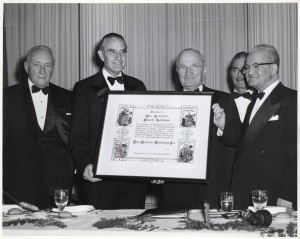 Above: Charles H. Silver, Governor Averell Harriman, President Harry Truman and others at a ceremony in honor of Harriman.
Above: Charles H. Silver, Governor Averell Harriman, President Harry Truman and others at a ceremony in honor of Harriman.
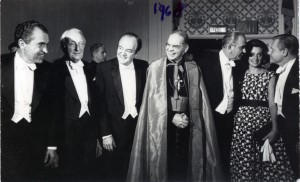 Above: Richard Nixon, Charles H. Silver, Hubert Humphrey, Terence Cardinal Cooke, President Lyndon Johnson, Margaretta “Happy” Rockefeller and Governor Nelson Rockefeller at the 1968 Al Smith Dinner.
Above: Richard Nixon, Charles H. Silver, Hubert Humphrey, Terence Cardinal Cooke, President Lyndon Johnson, Margaretta “Happy” Rockefeller and Governor Nelson Rockefeller at the 1968 Al Smith Dinner.
In addition to his medical and political interests, Silver was a strong advocate of public education and served for six years as Chairman of the New York City Board of Education. The Silver collection in the Mount Sinai Archives includes photographs of Silver with every U.S. President from Truman to Carter, two of which are presented here. No full-length biography of Silver has yet been written, but his eventful career is an important part of the story of New York City in the twentieth century.
Mar 18, 2016
 The Mount Sinai Archives is very happy to announce the unveiling of our new website. The new main page has gathered together under easy drop-down sections all of the information that was formerly embedded in text and hard to find. (We also really like the images that adorn the tops of the pages.) Our site now matches the style of our institutional web presence and, most importantly, provides much better visibility to our electronic resources. We have gathered onto the Digital Collections page a link to our digital repository, DSpace, a link to our image database, as well as a link to our digitized AV collection. Soon we will be updating the main pages of those programs as well, and we hope over the course of this year to be able to add a site for our oral history collection, which dates back to the 1960’s and features interviews with Mount Sinai physicians and leaders. Also of note is that on the Historical Resources page, we have gathered together links to digitized versions of histories relating to Mount Sinai, its staff and departments.
The Mount Sinai Archives is very happy to announce the unveiling of our new website. The new main page has gathered together under easy drop-down sections all of the information that was formerly embedded in text and hard to find. (We also really like the images that adorn the tops of the pages.) Our site now matches the style of our institutional web presence and, most importantly, provides much better visibility to our electronic resources. We have gathered onto the Digital Collections page a link to our digital repository, DSpace, a link to our image database, as well as a link to our digitized AV collection. Soon we will be updating the main pages of those programs as well, and we hope over the course of this year to be able to add a site for our oral history collection, which dates back to the 1960’s and features interviews with Mount Sinai physicians and leaders. Also of note is that on the Historical Resources page, we have gathered together links to digitized versions of histories relating to Mount Sinai, its staff and departments.
Please, check out our new website, and let us know if you have any comments or questions. We can be reached at MSarchives@mssm.edu.
[Edit: As of Summer 2022, the Archives no longer uses DSpace.]






